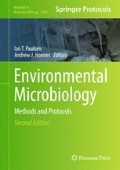Abstract
Genetic fingerprinting techniques for microbial community analysis have evolved over the last decade into standard applications for efficient and fast differentiation of microbial communities based on their diversity. These techniques commonly analyze the diversity of PCR products amplified from extracted environmental DNA usually utilizing primers hybridizing to suspected conserved regions of the targeted genes. In comparison to the more commonly applied terminal restriction fragment length polymorphism (TRFLP) or denaturing gradient gel electrophoresis (DGGE) techniques, the here-described single-strand conformation polymorphism (SSCP) fingerprinting technique features some advantageous key characteristics. (1) Primers for the polymerase chain reaction (PCR) do only need minimal 5′-end alterations; (2) SSCP is adaptable to high throughput applications in automated sequencers; and (3) a second dimension in the SSCP gel electrophoresis can be implemented to obtain high resolution 2D gels. One central key requirement for SSCP gel electrophoresis is a tight temperature control. Gels that run at different temperatures will produce entirely different fingerprints. This can be exploited for an improved analysis of highly diverse communities by running the same template at different temperatures or by 2D-SSCP gel electrophoresis.
Access this chapter
Tax calculation will be finalised at checkout
Purchases are for personal use only
References
Liu WT et al (1997) Characterization of microbial diversity by determining terminal restriction fragment length polymorphisms of genes encoding 16S rRNA. Appl Environ Microbiol 63:4516–4522
Muyzer G, de Waal EC, Uitterlinden AG (1993) Profiling of complex microbial populations by denaturing gradient gel electrophoresis analysis of polymerase chain reaction-amplified genes coding for 16S rRNA. Appl Environ Microbiol 59:695–700
Muyzer G, Smalla K (1998) Application of denaturing gradient gel electrophoresis (DGGE) and temperature gradient gel electrophoresis (TGGE) in microbial ecology. Antonie Leeuwenhoek 73:127–141
Orita M et al (1989) Detection of polymorphisms of human DNA by gel-electrophoresis as single-strand conformation polymorphisms. Proc Natl Acad Sci U S A 86:2766–2770
Schwieger F, Tebbe CC (1998) A new approach to utilize PCR-single-strand-conformation polymorphism for 16S rRNA gene-based microbial community analysis. Appl Environ Microbiol 64:4870–4876
Hayashi K (1992) PCR-SSCP - a method for detection of mutations. Genet Anal Biomol Eng 9:73–79
Lee DH, Zo YG, Kim SJ (1996) Nonradioactive method to study genetic profiles of natural bacterial communities by PCR-single-strand-conformation polymorphism. Appl Environ Microbiol 62:3112–3120
Tebbe CC et al (2001) Single-strand conformation polymorphism (SSCP) for microbial community analysis. In: Rochelle PA (ed) Environmental molecular microbiology: protocols and applications. Horizon Scientific Press, Wymondham, pp 161–175
Peters S et al (2000) Succession of microbial communities during hot composting as detected by PCR-single-strand-conformation polymorphism-based genetic profiles of small-subunit rRNA genes. Appl Environ Microbiol 66:930–936
Dohrmann AB, Tebbe CC (2005) Effect of elevated tropospheric ozone on the structure of bacterial communities inhabiting the rhizosphere of herbaceous plants native to Germany. Appl Environ Microbiol 71:7750–7758
Atha DH et al (1998) Detection of p53 point mutations by single strand conformation polymorphism: analysis by capillary electrophoresis. Electrophoresis 19:172–179
King S, McCord BR, Riefler RG (2005) Capillary electrophoresis single-strand conformation polymorphism analysis for monitoring soil bacteria. J Microbiol Methods 60:83–92
Schmalenberger A, Tebbe CC (2002) Bacterial community composition in the rhizosphere of a transgenic, herbicide-resistant maize (Zea mays) and comparison to its non-transgenic cultivar Bosphore. FEMS Microbiol Ecol 40:29–37
Schmalenberger A, Tebbe CC (2003) Bacterial diversity in maize rhizospheres: conclusions on the use of genetic profiles based on PCR-amplified partial small subunit rRNA genes in ecological studies. Mol Ecol 12:251–261
Fracchia L et al (2006) Bacterial diversity in a finished compost and vermicompost – differences revealed by cultivation-independent analyses of PCR-amplified 16S rRNA genes. Appl Microbiol Biotechnol 71:942–952
Schmalenberger A et al (2008) Two-dimensional single strand conformation polymorphism (SSCP) of 16S rRNA gene fragments reveals highly dissimilar bacterial communities in an acidic fen. Eur J Soil Biol 44:495–500
Schmalenberger A, Schwieger F, Tebbe CC (2001) Effect of primers hybridizing to Different evolutionarily conserved regions of the small-subunit rRNA gene in PCR-based microbial community analyses and genetic profiling. Appl Environ Microbiol 67:3557–3563
Liu Q, Sommer SS (2001) Multi-conditional SSCP (SSCP5): a rapid method for mutation scanning with virtually 100% sensitivity. Patent US, City of Hope, USA
Acknowledgements
This work was supported by the British Natural Environment Research Council (NERC).
Author information
Authors and Affiliations
Editor information
Editors and Affiliations
Rights and permissions
Copyright information
© 2014 Springer Science+Business Media, LLC
About this protocol
Cite this protocol
Schmalenberger, A., Tebbe, C.C. (2014). Profiling the Diversity of Microbial Communities with Single-Strand Conformation Polymorphism (SSCP). In: Paulsen, I., Holmes, A. (eds) Environmental Microbiology. Methods in Molecular Biology, vol 1096. Humana Press, Totowa, NJ. https://doi.org/10.1007/978-1-62703-712-9_6
Download citation
DOI: https://doi.org/10.1007/978-1-62703-712-9_6
Published:
Publisher Name: Humana Press, Totowa, NJ
Print ISBN: 978-1-62703-711-2
Online ISBN: 978-1-62703-712-9
eBook Packages: Springer Protocols

